Serengeti National Park Guide: Africa’s Wildlife Jewel

Serengeti National Park Guide: Africa’s Wildlife Jewel
The Serengeti National Park is not just a destination—it’s an experience that defines the essence of Africa. Known for its vast savannas, dramatic wildlife spectacles, and breathtaking landscapes, the Serengeti is a UNESCO World Heritage Site and one of the most iconic safari destinations on Earth. Every year, thousands of travelers venture into this untamed wilderness to witness the Great Migration, encounter the Big Five, and immerse themselves in a world where nature reigns supreme.
In this comprehensive guide, we’ll explore everything you need to know about the Serengeti—from its legendary wildlife and best safari experiences to the ideal times to visit and essential travel tips. Whether you’re planning your first safari or seeking deeper insights into this natural wonder, this guide will help you uncover the magic of the Serengeti.
Table of Contents
Introduction: Where the Earth Still Breathes Wild
Beneath the vast African sky, where golden grasses ripple like a living ocean, lies Serengeti National Park – a realm where nature’s ancient rhythms continue undisturbed. This UNESCO World Heritage Site represents one of Earth’s last truly wild places, where the circle of life plays out on a scale unmatched anywhere else on the planet. The very name “Serengeti,” derived from the Maasai word “Siringet,” meaning “endless plains,” perfectly captures the breathtaking expanse that stretches beyond the horizon in every direction.
For those who venture here, the Serengeti offers more than just a safari – it provides a profound reconnection with the primal essence of our world. The air thrums with the distant roar of lions, the earth trembles with the thunder of a million hooves during the Great Migration, and every sunset paints the savanna in colors so vivid they seem imagined. This is where documentaries come to life, where every game drive becomes an expedition into the heart of wilderness itself.

The Living Tapestry of the Serengeti Ecosystem
The magic of the Serengeti lies in its intricate web of interconnected life. The park’s diverse habitats – from the short-grass plains of the south to the acacia-dotted savannas of the central region and the riverine forests along the Grumeti and Mara Rivers – each support unique communities of wildlife. These ecosystems have evolved together over millennia, creating perfect harmony between predators and prey, grazers and grasslands, weather patterns and wildlife movements.
At the foundation of this complex system lies the rain. The seasonal showers dictate everything from the growth of nutrient-rich grasses to the timing of the Great Migration. During the rainy season, the southern plains transform into a verdant paradise, drawing pregnant wildebeest to give birth in what becomes the world’s largest nursery. As the dry season takes hold, the endless search for water and fresh grazing pushes the herds northward in a cycle as old as time itself.
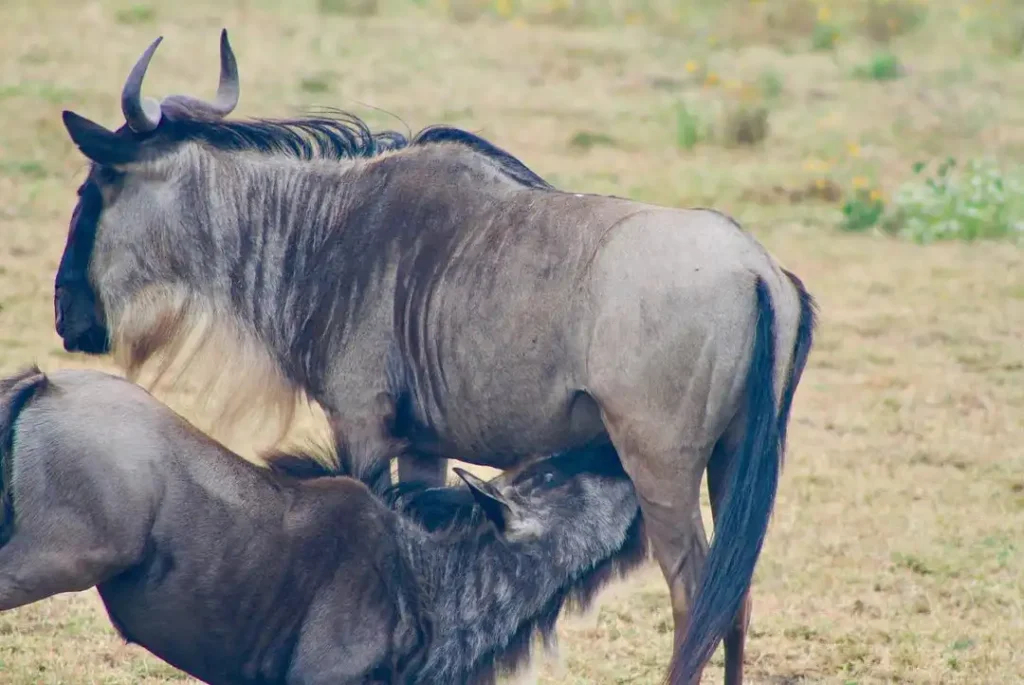
The Great Migration: Nature’s Greatest Performance
To witness the Great Migration is to observe one of nature’s most spectacular phenomena. This endless journey of over 1.5 million wildebeest, joined by hundreds of thousands of zebras and gazelles, creates a living river of animals that flows across the Serengeti throughout the year. The migration isn’t a single event but a continuous, year-round movement dictated by rainfall and grazing conditions.
The most dramatic moments come during the river crossings, when herds gather at the banks of the Grumeti and Mara Rivers, mustering courage to plunge into waters teeming with enormous crocodiles. These crossings represent nature in its rawest form – a breathtaking display of life, death, survival, and renewal. The air fills with grunts and bellows as animals leap from steep banks, churning the water into froth, while crocodiles that have waited months for this moment strike with terrifying speed.
Yet the migration offers more than just these dramatic crossings. The calving season in the southern plains presents an equally remarkable spectacle, when hundreds of thousands of wildebeest calves are born within weeks of each other. This synchronized birthing overwhelms predators through sheer numbers, ensuring enough calves survive to continue the species. The plains become a nursery alive with the sounds of newborns taking their first wobbly steps, while lions, cheetahs, and hyenas patrol the edges of the herds, waiting for any opportunity.
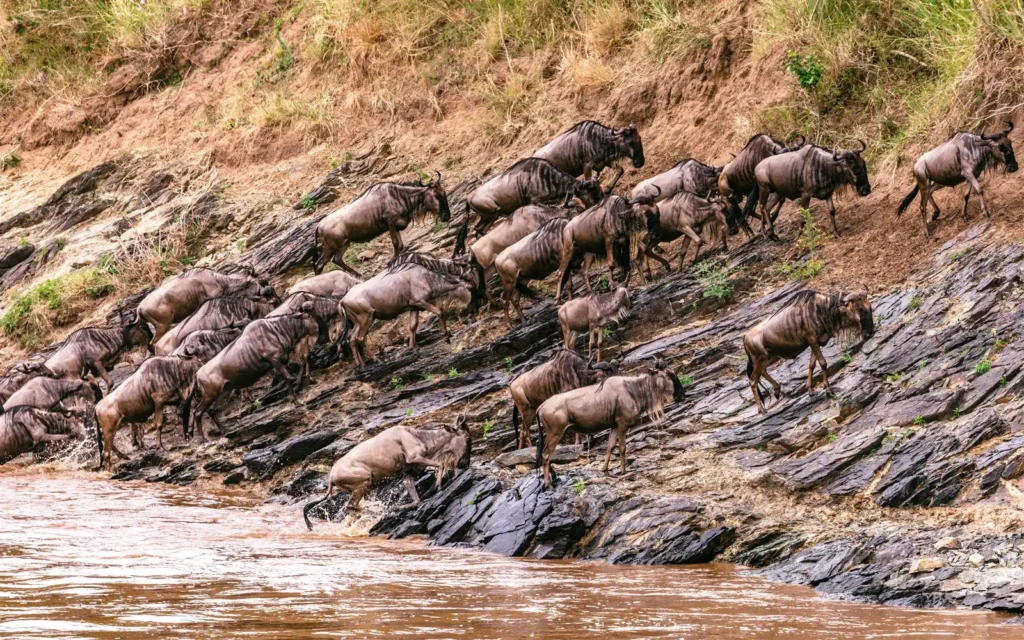
Beyond the Migration: The Serengeti’s Hidden Gems
While the Great Migration rightfully claims much of the Serengeti’s fame, the park offers countless other wonders for those who take the time to explore. The kopjes – ancient granite outcrops that rise dramatically from the plains – serve as islands of life in a sea of grass. These rocky formations provide shelter for everything from diminutive klipspringers to majestic lions that use the high vantage points to survey their domains.
The Seronera River Valley in the park’s center offers some of Africa’s best year-round game viewing. Here, the permanent water sources attract wildlife even during the dry season, making it possible to see all members of the Big Five in a single day. The riverine forests along the watercourses hide leopards in their dappled shadows, while the open grasslands allow cheetahs to stretch their legs in pursuit of gazelles.
Bird enthusiasts find equal delight in the Serengeti, where over 500 species fill the skies and trees with color and song. From the prehistoric-looking secretary birds that stalk through the grass to the vibrant lilac-breasted rollers that perch prominently on acacia branches, the avian life adds another dimension to the safari experience. The wet season brings migratory species from Europe and Asia, while resident birds like the kori bustard (Africa’s heaviest flying bird) and the martial eagle (with its 6-foot wingspan) remain year-round.

The Human Connection: Maasai Culture and Conservation
The story of the Serengeti isn’t complete without acknowledging the indigenous Maasai people who have lived alongside this wilderness for centuries. Their traditional pastoral lifestyle, based on cattle herding, has evolved in harmony with the wildlife, creating a model of coexistence that modern conservationists study with great interest. Many safari operators now include visits to Maasai villages, where visitors can learn about traditional medicines derived from local plants, the significance of intricate beadwork, and the coming-of-age rituals that have defined Maasai culture for generations.
Modern conservation efforts in the Serengeti represent one of Africa’s greatest success stories. Through careful management, anti-poaching initiatives, and sustainable tourism practices, the park has maintained its ecological balance while welcoming visitors from around the world. The Serengeti’s research projects – from lion population studies to wildebeest migration tracking – contribute valuable data to global conservation science, helping protect ecosystems far beyond Tanzania’s borders.
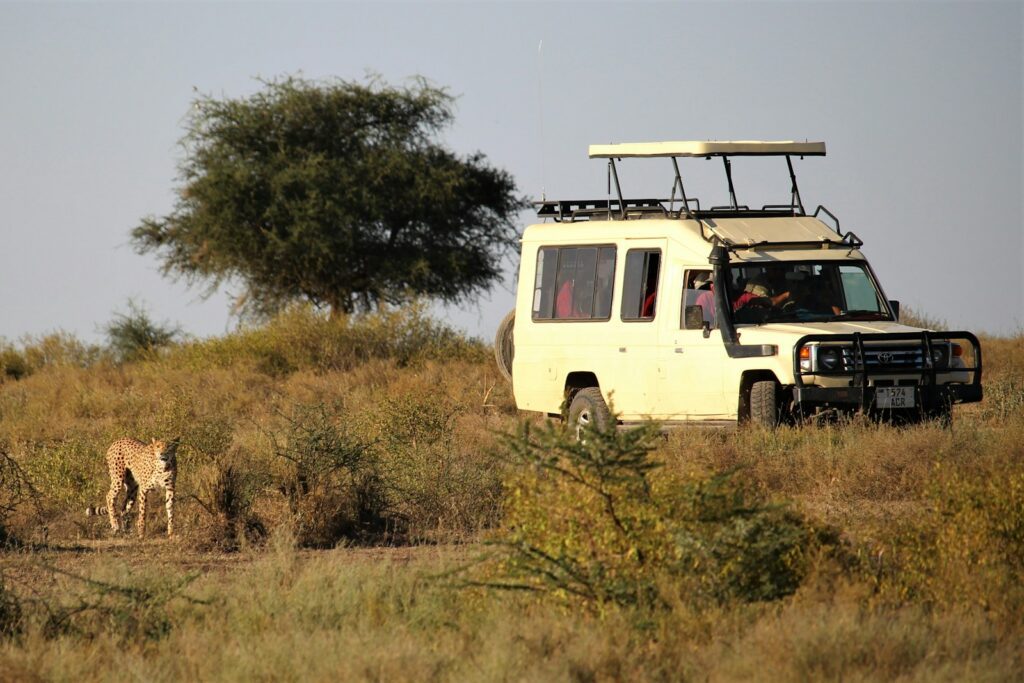
Experiencing the Serengeti: Beyond the Game Drive
While traditional game drives remain the cornerstone of any Serengeti safari, innovative experiences now allow visitors to connect with the wilderness in new ways. Hot air balloon safaris at dawn offer a completely different perspective, floating silently above the plains as the sun rises and animals begin their daily routines. Walking safaris with armed guides provide an intimate, ground-level experience where guests learn to read animal tracks, identify medicinal plants, and understand the subtle signs of life in the bush.
For those seeking deeper immersion, several camps offer sleep-out experiences where guests spend the night on raised platforms under the stars, listening to the nocturnal sounds of the savanna. Photography hides positioned near waterholes allow unprecedented close encounters with wildlife, perfect for capturing those once-in-a-lifetime shots without disturbing the animals’ natural behaviors.

When to Visit: The Serengeti Through the Seasons
The Serengeti’s ever-changing face means there’s no single “best” time to visit – rather, each season offers unique rewards. The dry season from June to October provides excellent game viewing as animals congregate around remaining water sources, with the added drama of river crossings in the north. The wet season from November to May brings lush landscapes, fewer visitors, and the unforgettable spectacle of newborn animals in the southern plains.
Even the “green season” (April and May) has its charms, when the park dons its most vibrant colors and birdlife reaches its peak. While some lodges close during this period, those that remain open offer exceptional value and a more exclusive experience, with storm-washed skies creating dramatic backdrops for photography.
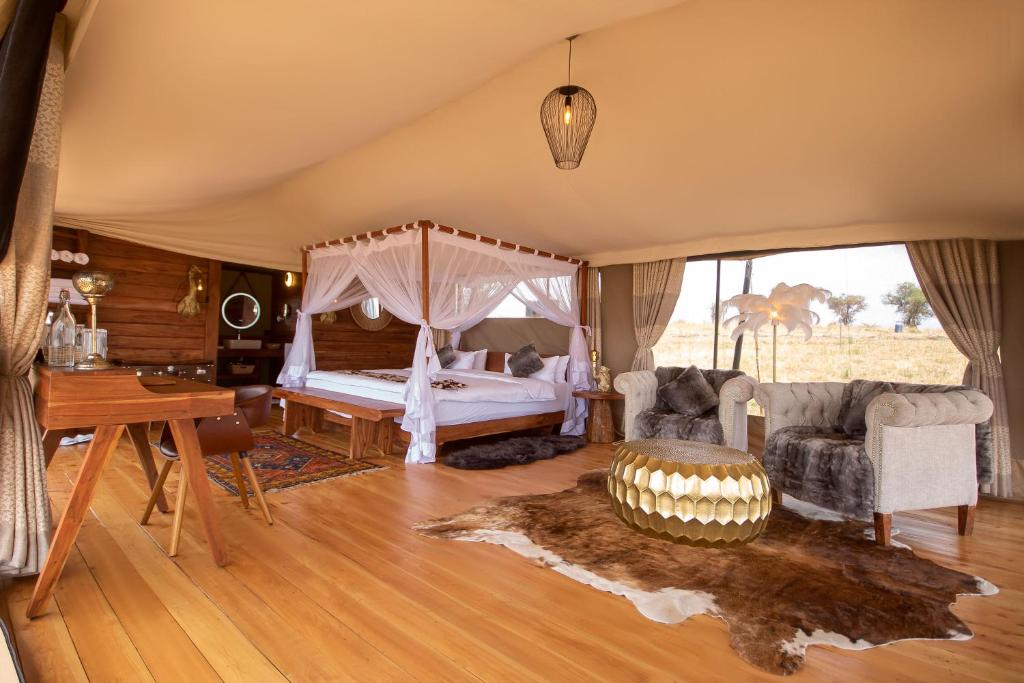

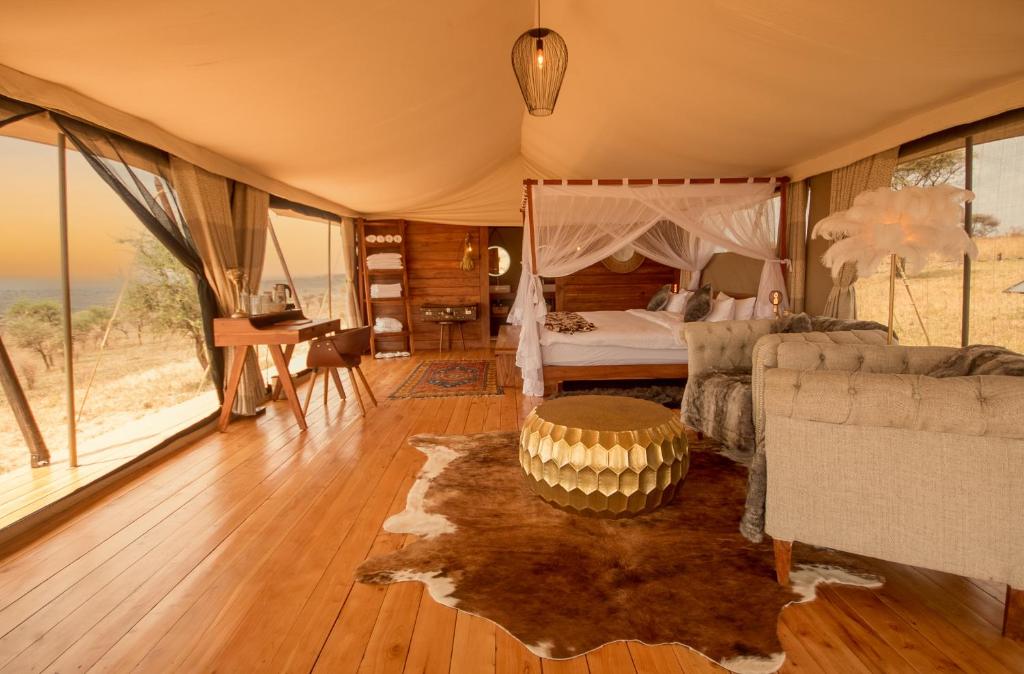
Where to Stay: From Luxury to Authentic Bush Camps
Accommodation options in the Serengeti range from opulent permanent lodges with every conceivable amenity to mobile tented camps that follow the migration’s path. Luxury properties like Singita Faru Faru and Four Seasons Safari Lodge offer spa services, infinity pools, and gourmet dining without sacrificing authentic safari atmosphere. For those seeking closer connection to the wilderness, classic tented camps like Serengeti Under Canvas provide elegant simplicity with comfortable beds, ensuite bathrooms, and the sounds of the wild just beyond the canvas walls.
The most adventurous travelers can opt for fly camping experiences, spending nights in simple dome tents with just a mosquito net between them and the African night. Community-run lodges like Dunia Camp not only offer wonderful accommodations but also directly support local conservation and education initiatives.

Planning Your Serengeti Adventure
A successful Serengeti safari requires thoughtful preparation. Visitors should consider combining the Serengeti with other northern Tanzania highlights like Ngorongoro Crater or Tarangire National Park for a more comprehensive experience. Packing should focus on neutral-colored clothing, quality binoculars, and reliable camera equipment, while leaving unnecessary valuables at home.
Health preparations include checking vaccination requirements (yellow fever certification may be needed depending on travel history) and discussing malaria prophylaxis with a travel doctor. Travel insurance with emergency evacuation coverage is essential when visiting remote wilderness areas.
Perhaps most importantly, travelers should approach their Serengeti experience with patience and presence. Wildlife sightings can’t be scheduled, and some of the most magical moments come when least expected – a leopard descending from a tree at dusk, a herd of elephants crossing the road with quiet dignity, or simply sitting quietly at a waterhole as the African day transitions to night.

Conclusion: The Call of the Wild
The Serengeti National Park remains one of those rare places on Earth where nature still operates by its own rules, where the drama of survival plays out daily on a grand scale, and where visitors can’t help but feel transformed by the experience. It’s a place that lingers in the memory long after departure, calling travelers back to its endless plains time and again.
For those who answer that call, the Serengeti offers more than just wildlife sightings – it provides a profound reconnection with the natural world and our place within it. In an age of increasing urbanization and digital saturation, this vast wilderness reminds us of the beauty, power, and fragility of our planet’s wild spaces. The Serengeti doesn’t just deserve to be visited – it needs to be experienced, cherished, and protected, so future generations may also stand in awe of its timeless majesty.
As the sun sets over the savanna, painting the acacia trees in silhouette and turning the grasses to liquid gold, one truth becomes self-evident: the Serengeti isn’t just a destination. It’s a living testament to the enduring power of wilderness, a sanctuary for the soul, and quite possibly the closest we can come to experiencing the world as it once was.
Recent Posts





